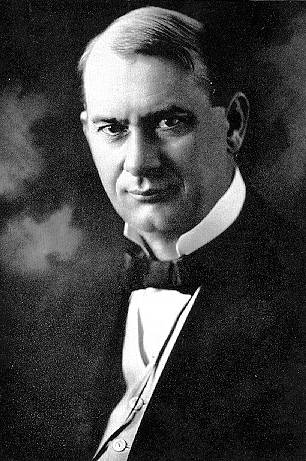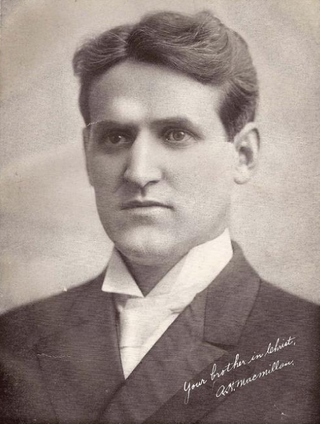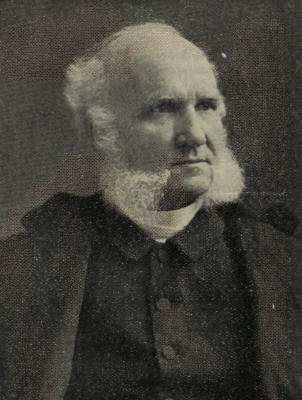
According to the Book of Revelation in the New Testament of the Christian Bible, Armageddon is the prophesied location of a gathering of armies for a battle during the end times, which is variously interpreted as either a literal or a symbolic location. The term is also used in a generic sense to refer to any end-of-the-world scenario. In Islamic theology, Armageddon is also mentioned in Hadith as the Greatest Armageddon or Al-Malhama Al-Kubra.

Jehovah's Witnesses is a nontrinitarian, millenarian, restorationist Christian denomination. In 2023, the group reported approximately 8.6 million members involved in evangelism, with around 20.5 million attending the annual Memorial of Christ's death. Jehovah's Witnesses believe that the destruction of the present world system at Armageddon is imminent, and the establishment of God's kingdom over earth is the only solution to all of humanity's problems.

Charles Taze Russell, or Pastor Russell, was an American Adventist minister from Pittsburgh, Pennsylvania, and founder of the Bible Student movement. He was an early Christian Zionist.

The New World Translation of the Holy Scriptures is a translation of the Bible published by the Watch Tower Bible and Tract Society; it is used and distributed by Jehovah's Witnesses. The New Testament portion was released first, in 1950, as the New World Translation of the Christian Greek Scriptures, with the complete New World Translation of the Bible released in 1961.

Jehovah's Witnesses have been criticized by adherents of mainstream Christianity, members of the medical community, former Jehovah's Witnesses, and commentators with regard to their beliefs and practices. The Jehovah's Witness movement's leaders have been accused of practicing doctrinal inconsistencies and making doctrinal reversals, making failed predictions, mistranslating the Bible, harshly treating former Jehovah's Witnesses, and leading the Jehovah's Witness movement in an authoritarian and coercive manner. Jehovah's Witnesses have also been criticized because they reject blood transfusions, even in life-threatening medical situations, and for failing to report cases of sexual abuse to the authorities. Many of the claims are denied by Jehovah's Witnesses and some have also been disputed by courts and religious scholars.

Joseph Franklin Rutherford, also known as Judge Rutherford, was an American religious leader and the second president of the incorporated Watch Tower Bible and Tract Society. He played a primary role in the organization and doctrinal development of Jehovah's Witnesses, which emerged from the Bible Student movement established by Charles Taze Russell.
The Watchtower Announcing Jehovah's Kingdom is an illustrated religious magazine, published by the Watch Tower Bible and Tract Society of Pennsylvania. Jehovah's Witnesses distribute The Watchtower—Public Edition, along with its companion magazine, Awake!.
The Watch Tower Bible and Tract Society produces a significant amount of printed and electronic literature, primarily for use by Jehovah's Witnesses. Their best known publications are the magazines, The Watchtower and Awake!
Kingdom songs are the hymns sung by Jehovah's Witnesses at their religious meetings. Since 1879, the Watch Tower Society has published hymnal lyrics; by the 1920s they had published hundreds of adapted and original songs, and by the 1930s they referred to these as "Kingdom songs" in reference to God's Kingdom.

The Bible Student movement is a Millennialist Restorationist Christian movement. It emerged in the United States from the teachings and ministry of Charles Taze Russell (1852–1916), also known as Pastor Russell, and his founding of the Zion's Watch Tower Tract Society in 1881. Members of the movement have variously referred to themselves as Bible Students, International Bible Students, Associated Bible Students, or Independent Bible Students.
The Dawn Bible Students Association is a Christian organization and movement, and a legal entity used by a branch of the Bible Student movement.

The Watch Tower Bible and Tract Society of Pennsylvania is a non-stock, not-for-profit organization headquartered in Warwick, New York. It is the main legal entity used worldwide by Jehovah's Witnesses to direct, administer, and disseminate doctrines for the group and is often referred to by members of the denomination simply as "the Society". It is the parent organization of a number of Watch Tower subsidiaries, including the Watchtower Society of New York and the International Bible Students Association. The number of voting shareholders of the corporation is limited to between 300 and 500 "mature, active and faithful" male Jehovah's Witnesses. About 5,800 Jehovah's Witnesses provide voluntary unpaid labor, as members of a religious order, in three large Watch Tower Society facilities in New York. Nearly 15,000 other members of the order work at the Watch Tower Society's other facilities worldwide.
Jehovah's Witnesses originated as a branch of the Bible Student movement, which developed in the United States in the 1870s among followers of Christian restorationist minister Charles Taze Russell. Bible Student missionaries were sent to England in 1881 and the first overseas branch was opened in London in 1900. The group took on the name International Bible Students Association and by 1914 it was also active in Canada, Germany, Australia, and other countries.
The eschatology of Jehovah's Witnesses is central to their religious beliefs. They believe that Jesus Christ has been ruling in heaven as king since 1914, a date they believe was prophesied in Scripture, and that after that time a period of cleansing occurred, resulting in God's selection of the Bible Students associated with Charles Taze Russell to be his people in 1919. They believe the destruction of those who reject their message and thus willfully refuse to obey God will shortly take place at Armageddon, ensuring that the beginning of the new earthly society will be composed of willing subjects of that kingdom.
"Faithful and discreet slave" is the term used by Jehovah's Witnesses to describe the group's Governing Body in its role of directing doctrines and teachings. The group is described as a "class" of "anointed" Christians that operates under the direct control of Jesus Christ to exercise teaching authority in all matters pertaining to doctrine and articles of faith.
The doctrines of Jehovah's Witnesses have developed since the publication of The Watchtower magazine began in 1879. Early doctrines were based on interpretations of the Bible by Watch Tower Bible & Tract Society founder Charles Taze Russell, then added to, altered, or discarded by his successors, Joseph Rutherford and Nathan Knorr. Since 1976, doctrinal changes have been made at closed meetings of the group's Governing Body, whose decisions are described as "God's progressive revelations". These teachings are disseminated through The Watchtower, and at conventions and congregation meetings. Most members of the denomination outside the Governing Body play no role in the development of doctrines and are expected to adhere to all those decided at the Warwick, NY headquarters. Jehovah's Witnesses are taught to welcome doctrinal changes, regarding such "adjustments" as "new light" or "new understanding" from God and proving that they are on the "path of the righteous".

Alexander Hugh Macmillan, also referred to as A. H. Macmillan, was an important member of the Bible Students, and later, of Jehovah’s Witnesses. He became a board member of the Watch Tower Bible and Tract Society in 1917 and again in 1920. He presented a history of the religious movement in his book Faith on the March, published in 1957.

Joseph Augustus Seiss was an American theologian and Lutheran minister. He was known for his religious writings on pyramidology and dispensationalism.
The beliefs of Jehovah's Witnesses are based on the Bible teachings of Charles Taze Russell—founder of the Bible Student movement—and successive presidents of the Watch Tower Society, Joseph Franklin Rutherford, and Nathan Homer Knorr. Since 1976, all doctrinal decisions have been made by the Governing Body of Jehovah's Witnesses, a group of elders at the denomination's headquarters. These teachings are disseminated through The Watchtower magazine and other publications of Jehovah's Witnesses, and at conventions and congregation meetings.
Watch Tower Bible and Tract Society publications have made a series of predictions about Christ's Second Coming and the advent of God's kingdom, each of which has gone unfulfilled. Almost all the predictions for 1878, 1881, 1914, 1918, and 1925 were later reinterpreted as a confirmation of the eschatological framework of the Bible Student movement and Jehovah's Witnesses, with many of the predicted events viewed as having taken place invisibly. Further expectations were held for the arrival of Armageddon in 1975.










